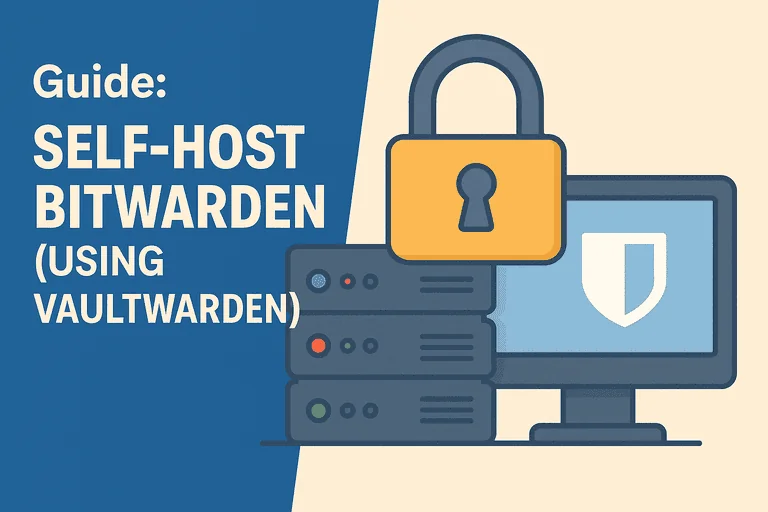Introduction
Looking for a secure and self-hosted password manager? Vaultwarden (a lightweight Bitwarden-compatible server) is the perfect choice for privacy-focused users who want full control over their credentials. In this guide, you’ll learn how to install and configure Vaultwarden on your own server.
Who is this for?
- Privacy-minded individuals and teams
- Beginners who want a secure password manager without third-party services
- Self-hosting enthusiasts running small servers or Raspberry Pi
What you’ll get:
- A working Vaultwarden instance
- Access to Bitwarden apps and extensions
- Optional HTTPS and backup configuration
Why Vaultwarden?
| Feature | Vaultwarden |
|---|---|
| Open-Source | Yes, under GPL-3.0 |
| Lightweight | Runs on Raspberry Pi or small VPS |
| Compatible with | Bitwarden clients (browser/app) |
| Easy to Deploy | Docker, systemd, manual options |
| Free & Self-Hosted | Yes – no subscription required |
Note: Bitwarden itself offers self-hosting too, but requires more resources. Vaultwarden is a lighter, Rust-based alternative.
Requirements
- Linux server or Raspberry Pi (1vCPU, 512MB+ RAM)
- Docker & Docker Compose installed
- Public domain name (optional for HTTPS)
- Port 80/443 open if using reverse proxy
Optional:
- Traefik or NGINX reverse proxy
- HTTPS (Let’s Encrypt)
- Backup storage (for vault data)
Step-by-Step Installation
1. Prepare Your Server
Ensure Docker and Docker Compose are installed:
sudo apt update && sudo apt install docker.io docker-compose -y
sudo systemctl enable docker2. Create Docker Compose File
In your home directory, create a folder:
mkdir ~/vaultwarden && cd ~/vaultwardenCreate docker-compose.yml:
version: '3'
services:
vaultwarden:
image: vaultwarden/server:latest
container_name: vaultwarden
restart: unless-stopped
ports:
- "80:80"
volumes:
- ./vw-data:/data
environment:
- ADMIN_TOKEN=your_secure_token_hereTip: Generate a strong admin token with
openssl rand -base64 32.
3. Start the Server
docker-compose up -dVaultwarden should now be running at http://your-ip
First-Time Setup
- Visit
http://your-ip - Register a new account (this becomes your main user)
- Optional: Visit
http://your-ip/adminand log in with the token - Configure settings like domain, registration policy, etc.
Enable HTTPS (Optional)
If you have a domain:
- Set up NGINX or Traefik reverse proxy
- Use Let’s Encrypt to enable HTTPS
Sample NGINX config:
server {
listen 80;
server_name passwords.yourdomain.com;
return 301 https://$host$request_uri;
}
server {
listen 443 ssl;
server_name passwords.yourdomain.com;
ssl_certificate /etc/letsencrypt/live/yourdomain.com/fullchain.pem;
ssl_certificate_key /etc/letsencrypt/live/yourdomain.com/privkey.pem;
location / {
proxy_pass http://localhost:80;
proxy_set_header Host $host;
proxy_set_header X-Real-IP $remote_addr;
proxy_set_header X-Forwarded-For $proxy_add_x_forwarded_for;
}
}Using Bitwarden Clients
You can now use:
- Bitwarden browser extensions (Chrome, Firefox, etc.)
- Bitwarden mobile apps
- Desktop Bitwarden clients
Go to settings and set your custom server URL:
https://passwords.yourdomain.com
Backups & Maintenance
Backup Vaultwarden Data:
tar czvf vw-backup-$(date +%F).tar.gz ~/vaultwarden/vw-dataAutomate backups with cron or external sync tools.
Update Vaultwarden:
cd ~/vaultwarden
docker-compose pull
docker-compose up -dComparison: Vaultwarden vs Bitwarden Cloud
| Feature | Vaultwarden | Bitwarden Cloud |
| Hosting | Self-hosted | Cloud by Bitwarden |
| Cost | Free | Free/Paid tiers |
| Admin Access | Full (via token) | Limited |
| Privacy | Full control | Trust in provider |
| Customization | High | Limited |
FAQs
Q: Is Vaultwarden safe?
A: Yes, it uses strong encryption and is widely used. Just ensure your server is secured.
Q: Can multiple users share the same instance?
A: Yes, but Vaultwarden lacks the full organization features of paid Bitwarden. Still great for families or small teams.
Q: Can I use 2FA?
A: Absolutely. Vaultwarden supports TOTP and WebAuthn (YubiKey, etc).
Final Thoughts
Vaultwarden is a powerful, no-cost way to gain control over your password security. In under 30 minutes, you can run your own secure vault and ditch third-party services.
Respect your data. Self-host your secrets.
Support SelfhostHero: Appreciate the guide? Share it or use our links for hardware and domains—help us grow privacy-first content like this

